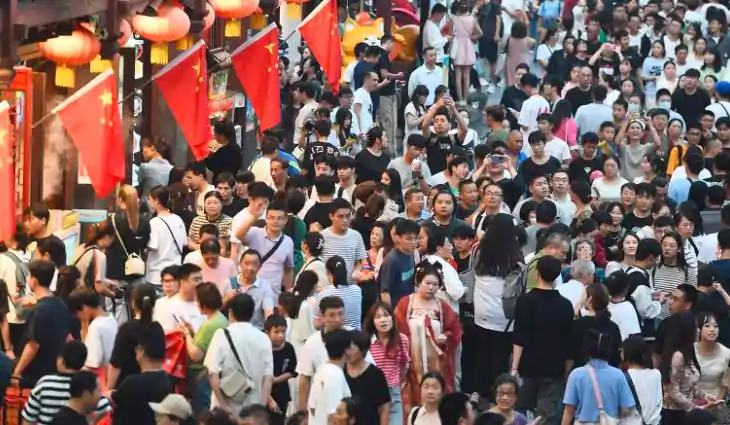Despite a frustrating post-pandemic recovery, the country could still reach its GDP growth target this year
China will release economic growth data for the third quarter on Wednesday (18), as the government seeks a target of around 5% growth this year.
Economists polled by Reuters expect China’s GDP (Gross Domestic Product) to have grown by 4.4% in the third quarter. This means that China remains on track to meet the target, following GDP growth of 4.5% in the first quarter and 6.3% in the second, compared to the previous year.
Although the target is one of the country’s lowest in decades, Chinese authorities have stepped up financial stabilization efforts in the real estate and banking sectors in recent months, as well as strengthening support for the country’s stock market and yuan.
Dozens of listed companies in China also announced or carried out share buyback plans on Tuesday, following a series of measures taken by the government to boost the stock market.
These measures highlight how the world’s second largest economy has failed to meet expectations of a post-pandemic recovery and how China’s economic planners are struggling to find growth drivers.
Forecasts for next year’s GDP growth are being lowered to around 4.5%. Consumer and business confidence remains weak, while the war between Israel and Hamas in the Middle East is adding uncertainty to the gloomy external demand for Chinese exports.
Here are five things to watch for in tomorrow’s release:
Consumption growth
Retail sales, which have been consistently weak this year despite the end of Covid-19 restrictions, finally showed signs of improvement in August, with a 4.6% year-on-year increase.
However, due to the problems in the housing market that still undermine consumer confidence, Alicia García-Herrero, chief economist for Asia-Pacific at Natixis, is wary of exaggerating the latest improvements in this key indicator of activity, especially when compared to a period of lockdowns in 2022.
“You can’t fall off the floor,” she said. “Any number that looks a little better [than the previous one] will be celebrated, especially with what’s going on in the world.”
An eight-day holiday this month probably helped maintain some momentum – domestic tourism and revenue were close to pre-pandemic levels – but this won’t be reflected in Wednesday’s data.
Problems in the housing market
Weak apartment sales and debt defaults by developers have become a persistent feature of a real estate market in deep crisis.
Beijing, keen to avoid another unsustainable cycle of credit-driven investment, has provided more support. This includes the removal of price restrictions for buying real estate in some major cities.
On the one hand, there are signs that the stabilization measures are having the desired effect. New home prices in 70 major cities were stable compared to the previous month in August.
But on the other hand, investment in real estate in the first eight months of the year fell by almost 9%, and the markets are worried about the possibility of contagion from a debt crisis at Country Garden, China’s largest private sector developer, which has warned that it may not be able to meet all its overseas payment obligations.
Export prospects deteriorate
Weak international demand has become an acute pressure point for policymakers in Beijing, a drastic change from the three years of lockdown during the pandemic, when China’s exports helped prop up the economy.
Official data from July showed that China’s exports, in US dollar terms, fell by 14.5%, the biggest drop since the start of the pandemic. Although still in negative territory, the situation has improved, with September’s exports falling 6.2% year-on-year, compared to an 8.8% drop in August.
Trinh Nguyen, senior economist for emerging Asia at Natixis, pointed out that the war between Israel and Hamas has complicated China’s foreign trade prospects. China, with inflation close to zero, seems to be protected from rising fuel prices, but geopolitical tensions between Beijing and the West are worsening.
In an “increasingly bifurcated world”, supply chains are gradually diversifying away from exclusive dependence on China, which means that “things that would be exported from China are increasingly being exported from elsewhere”, she said.
Doubts about investment
Investment in fixed assets, an important measure of capital spending in China, grew again in 2023, with just over 3% in the first eight months of the year.
This partly reflects the state’s push to increase investment in industry, as China moves away from an over-reliance on real estate and financial speculation.
Michael Pettis, senior research fellow at the Carnegie Endowment for International Peace think tank, is concerned that the state may be directing investment into non-productive sectors while policymakers pursue their annual GDP growth target.
“All that could be happening is that we’re moving from one place of non-productive investment – property – to another place of non-productive investment. If you look at it systemically, the only reason to expand manufacturing is because of an expansion in demand. We haven’t seen that.”
Stimulus requests and reforms
In the coming weeks, Beijing will host the third plenum of the Chinese Communist Party’s Central Committee, an important leadership meeting that in the past has been used to unveil economic reforms.
As China’s growth has slowed, economists – both local and foreign – have called on Beijing to boost domestic consumption by transferring money and assets to households, while improving the country’s social safety net and establishing more progressive taxation and new financing tools for local governments.
Ahead of the third plenary session, however, Bert Hofman, former World Bank director for China based in Beijing, expects more “tweaks rather than major actions”.
Taken together, the stabilization and support measures announced in recent months seem likely to “do the job” of achieving the GDP growth target of 5%, he said.
“Policymakers are quite comfortable with the direction the supply side of the economy is heading,” Hofman added.

